Askeland D.R., Fulay P.P. Essentials of Materials Science & Engineering
Подождите немного. Документ загружается.


12-54 Why does the martensite phase not appear on
the Fe-Fe
3
C phase diagram?
12-55 Compare the mechanical properties of marten-
site, pearlite, and bainite formed from eutectoid
steel composition.
12-56 A steel containing 0.95% C is heated to various
temperatures above the eutectoid temperature,
held for 1 h, and then quenched to room tem-
perature. Using Figure 12-28 determine the
amount and composition of any martensite that
forms when the heating temperature is:
(a) 728
C (b) 750
C
(c) 780
C (d) 850
C
12-57 A steel microstructure contains 75% martensite
and 25% ferrite; the composition of the marten-
site is 0.6% C. Using Figure 12-28, determine
(a) the temperature from which the steel was
quenched, and
(b) the carbon content of the steel.
12-58 A steel microstructure contains 92% martensite
and 8% Fe
3
C; the composition of the martensite
is 1.10% C. Using Figure 12-28, determine
(a) the temperature from which the steel was
quenched, and
(b) the carbon content of the steel.
12-59 A steel containing 0.8% C is quenched to pro-
duce all martensite. Estimate the volume change
that occurs, assuming that the lattice parameter
of the austenite is 3.6 A. Does the steel expand
or contract during quenching?
12-60 Describe the complete heat treatment required
to produce a quenched and tempered eutectoid
steel having a tensile strength of at least
862 MPa. Include appropriate temperatures.
12-61 Describe the complete heat treatment required
to produce a quenched and tempered eutectoid
steel having a HRC hardness of less than 50.
Include appropriate temperatures.
12-62 In eutectic alloys, the eutectic microconstituent
is generally the continuous one, but in the
eutectoid structures, the primary microconstitu-
ent is normally continuous. By describing the
changes that occur with decreasing temperature
in each reaction, explain why this di¤erence is
expected.
12-63 What is the tempering of steels? Why is temper-
ing necessary?
12-64 What phases are formed by the decomposition
of martensite?
12-65 What is tempered martensite?
12-66 If tempering results in the decomposition of
martensite, why should we form martensite in
the first place?
12-67 Describe the changes in properties that occur
upon the tempering of an eutectoid steel.
Design Problems
g
12-68 You wish to attach aluminum sheets to the
frame of the twenty-fourth floor of a sky-
scraper. You plan to use rivets made of an
age-hardenable aluminum, but the rivets must
be soft and ductile in order to close. After the
sheets are attached, the rivets must be very
strong. Design a method for producing, using,
and strengthening the rivets.
12-69 An age-hardened, Al-Cu bracket is used to
hold a heavy electrical-sensing device on the
outside of a steel-making furnace. Temper-
atures may exceed 200
C. Is this a good de-
sign? Explain. If it is not, design an appro-
priate bracket and explain why your choice is
acceptable.
12-70 You use an arc-welding process to join an
eutectoid steel. Cooling rates may be very high
following the joining process. Describe what
happens in the heat-a¤ected zone of the weld
and discuss the problems that might occur.
Design a joining process that may minimize
these problems.
C H A P T E R 12 Dispersion Stren gthening by Phase Transfor mations and Heat Treatment390

13
Heat Treatment of Steels and
Cast Irons
Have You Ever Wondered?
9 What is the most widely used engineered material?
9 What makes stainless steels ‘‘stainless’’?
9 What is the difference between cast iron and steel?
9 Are stainless steels magnetic?
9 Is a tin can made out of tin?
Ferrous alloys, which are based on iron-carbon
alloys, include plain-carbon steels, alloy and tool
steels, stainless steels, and cast irons. These
are the most widely used materials in the world.
In the history of civilization, these materials
made their mark by defining the Iron Age. Steels
typically are produced in two ways: by refining
iron ore or by recycling scrap steel.
In producing primary steel, iron ore (proc-
essed to contain 50 to 70% iron oxide, Fe
2
O
3
or
Fe
3
O
4
) is heated in a blast furnace in the pres-
ence of coke (a form of carbon) and oxygen. The
iron oxide is reduced into a crude molten
iron known as hot metal or pig iron. At about
@1600
C, this material contains about 95%
iron; 4% carbon; 0.3 to 0.9% silicon; 0.5% Mn;
391

and 0.025 to 0.05% of sulfur, phosphorus, and
titanium. Slag is a byproduct of the blast furnace
process. It contains silica, CaO, and other im-
purities in the form of a silicate melt.
Because the liquid pig iron contains a large
amount of carbon, oxygen is blown into it in the
basic oxygen furnace (BOF) to eliminate the ex-
cess carbon and produce liquid steel. Steel has a
carbon content up to a maximum of @2%. In the
second method, steel scrap is often melted in
an electric arc furnace. Many alloy and specialty
steels, such as stainless steels, are produced
using electric melting. Steel is one of the few ma-
terials that is nearly 100% recycled. Molten steels
(including stainless steels) often undergo further
refining. The goal here is to reduce the levels of
impurities such as phosphorus, sulfur, etc., and to
bring the carbon to a desired level.
Molten steel made by either route is poured
into molds to produce finished steel castings, or
cast continuously into shapes that are later proc-
essed through metal-forming techniques such as
rolling or forging. In the latter case, the steel
is either poured into large ingot molds or con-
tinuously cast into regular shapes.
All of the strengthening mechanisms discussed
in the previous chapters apply to at least some of the
ferrous alloys. In this chapter, we will discuss how
to use the eutectoid reaction to control the structure
and properties of steels through heat treatment and
alloying. We will also examine two special classes
of ferrous alloys: stainless steels and cast irons.
13-1 Designations and Classification of Steels
The dividing point between ‘‘steels’’ and ‘‘cast irons’’ is 2.11% C, where the eutectic
reaction becomes possible. For steels, we concentrate on the eutectoid portion of the
diagram (Figure 13-1) in which the solubility lines and the eutectoid isotherm are spe-
cially identified. The A
3
shows the temperature at which ferrite starts to form on cool-
ing; the A
cm
shows the temperature at which cementite starts to form; and the A
1
is the
eutectoid temperature.
Almost all of the heat treatments of steel are directed toward producing the mixture
of ferrite and cementite that gives the proper combination of properties. Figure 13-2
shows the three important microconstituents, or arrangements of ferrite and cementite,
that are usually sought. Pearlite is a microconstituent consisting of a lamellar mixture
of ferrite and cementite. In bainite, which is obtained by transformation of austenite at
a large undercooling, the cementite is more rounded than in pearlite. Tempered mar-
tensite, a mixture of very fine and nearly round cementite in a matrix of ferrite, forms
when martensite is reheated following its formation.
Designations The American Iron and Steel Institute (AISI) and Society of Auto-
motive Engineers (SAE) provide designation systems (Table 13-1) that use a four- or
five-digit number. The first two numbers refer to the major alloying elements present,
and the last two or three numbers refer to the percentage of carbon. An AISI 1040 steel
is a plain-carbon steel with 0.40% C. An SAE 10120 steel is a plain-carbon steel con-
taining 1.20% C. An AISI 4340 steel is an alloy steel containing 0.40% C. Note that the
American Society for Testing of Materials (ASTM) has a di¤erent way of classifying
steels. The ASTM has a list of specifications that describe steels suitable for di¤erent
applications. The following example illustrates the use of AISI numbers.
C HA P T E R 1 3 Heat Treatment of Steels and Cast Irons392
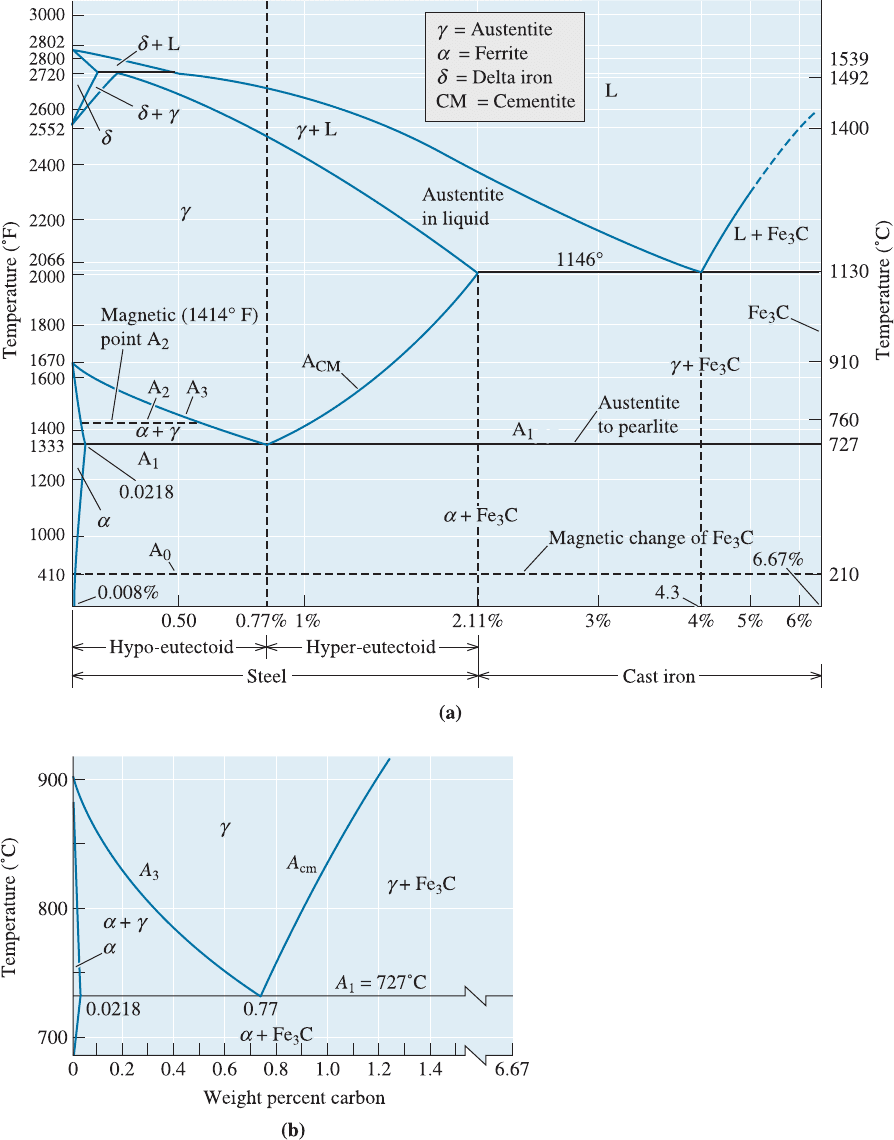
Figure 13-1 (a) An expanded version of the Fe-C diagram, adapted from several sources.
(b) The eutectoid portion of the Fe-Fe
3
C phase diagram.
13-1 Designations and Classification of Steels 393
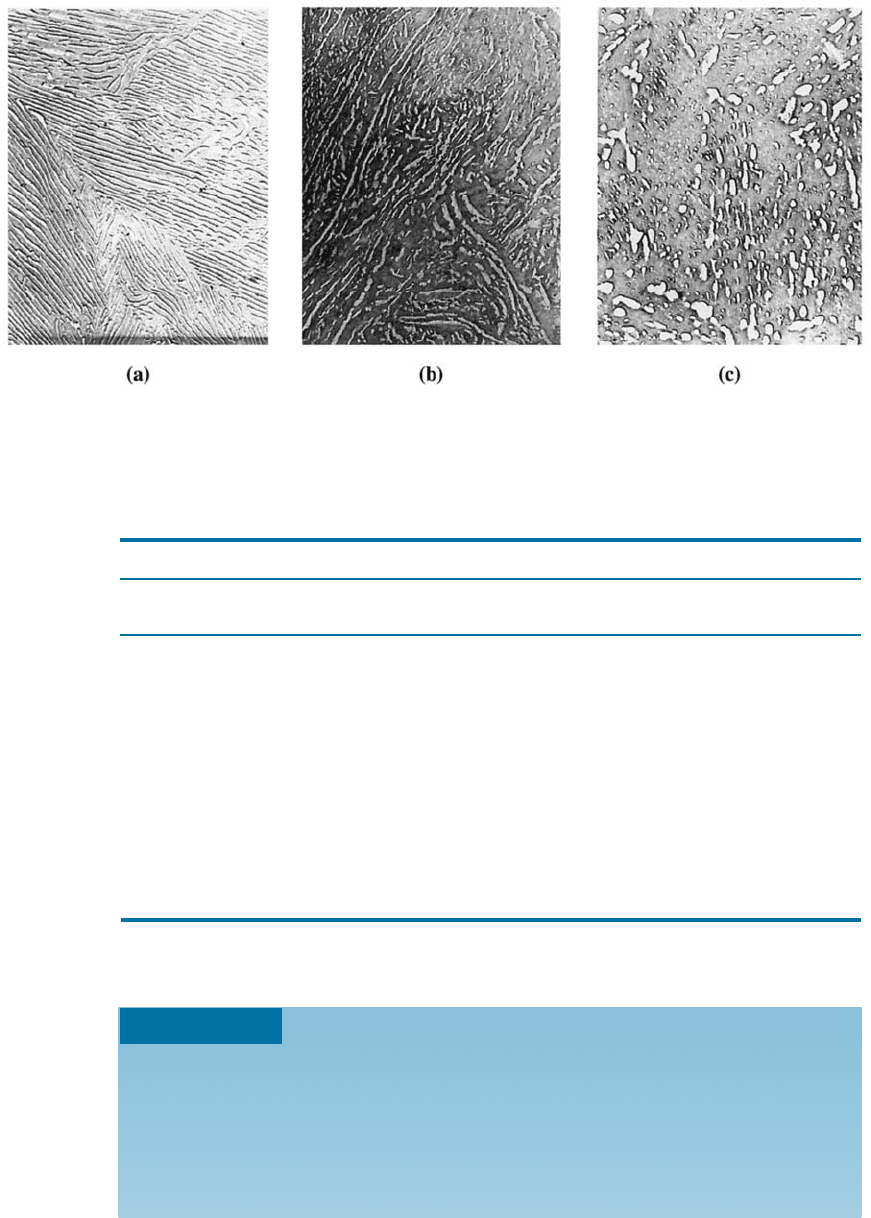
Figure 13-2 Electron micrographs of (a) pearlite, (b) bainite, and (c) tempered martensite,
illustrating the differences in cementite size and shape among these three microconstituents
(7500). (From The Making, Shaping, and Treating of Steel, 10th Ed. Courtesy of the
Association of Iron and Steel Engineers.)
TABLE 13-1 9 Compositions of selected AISI-SAE steels
AISI-SAE
Number % C % Mn % Si % Ni % Cr Others
1020 0.18–0.23 0.30 –0.60
1040 0.37–0.44 0.60 –0.90
1060 0.55–0.65 0.60 –0.90
1080 0.75–0.88 0.60 –0.90
1095 0.90–1.03 0.30 –0.50
1140 0.37–0.44 0.70 –1.00 0.08–0.13% S
4140 0.38–0.43 0.75 –1.00 0.15–0.30 0.80–1.10 0.15–0.25% Mo
4340 0.38–0.43 0.60–0.80 0.15–0.30 1.65–2.00 0.70–0.90 0.20–0.300% Mo
4620 0.17–0.22 0.45–0.65 0.15–0.30 1.65–2.00 0.20–0.30% Mo
52100 0.98–1.10 0.25–0.45 0.15–0.30 1.30–1.60
8620 0.18–0.23 0.70–0.90 0.15–0.30 0.40–0.70 0.40–0.60 0.15–0.25% Y
9260 0.56–0.64 0.75–1.00 1.80–2.20
EXAMPLE 13-1
Design of a Method to Determine AISI Number
An unalloyed steel tool used for machining aluminum automobile wheels has
been found to work well, but the purchase records have been lost and you do
not know the steel’s composition. The microstructure of the steel is tempered
martensite, and assume that you cannot estimate the composition of the steel
from the structure. Design a treatment that may help determine the steel’s car-
bon content.
C HA P T E R 1 3 Heat Treatment of Steels and Cast Irons394

SOLUTION
Assume that there is no access to equipment that would permit you to analyze
the chemical composition directly. Since the entire structure of the steel is a
very fine tempered martensite, we can do a simple heat treatment to produce a
structure that can be analyzed more easily. This can be done in two di¤erent
ways.
The first way is to heat the steel to a temperature just below the A
1
tem-
perature and hold for a long time. The steel overtempers and large Fe
3
C
spheres form in a ferrite matrix. We then estimate the amount of ferrite and
cementite and calculate the carbon content using the lever law. If we measure
16% Fe
3
C using this method, the carbon content is:
%Fe
3
C ¼
ðx 0:0218Þ
ð6:67 0:0218Þ
100 ¼ 16 or x ¼ 1:086% C
A better approach, however, is to heat the steel above the A
cm
to produce all
austenite. If the steel then cools slowly, it transforms to pearlite and a primary
microconstituent. If, when we do this, we estimate that the structure contains
95% pearlite and 5% primary Fe
3
C, then:
% Pearlite ¼
ð6:67 xÞ
ð6:67 0:77Þ
100 ¼ 95 or x ¼ 1:065% C
The carbon content is on the order of 1.065 to 1.086%, consistent with a 10110
steel. In this procedure, we assumed that the weight and volume percentages of
the microconstituents are the same, which is nearly the case in steels.
Classifications Steels can be classified based on their composition or the way they
have been processed. Carbon steels contain up to @2% carbon. These steels may also
contain other elements, such as Si (maximum 0.6%), copper (up to 0.6%), and Mn (up
to 1.65%). Decarburized steels contain less than 0.005% C. Ultra-low carbon steels
contain a maximum of 0.03% carbon. They also contain very low levels of other ele-
ments such as Si and Mn. Low-carbon steels contain 0.04 to 0.15% carbon. These low-
carbon steels are used for making car bodies and hundreds of other applications. Mild
steel contains 0.15 to 0.3% carbon. This steel is used in buildings, bridges, piping, etc.
Medium-carbon steels contain 0.3 to 0.6% carbon. These are used in making machi-
nery, tractors, mining equipment, etc. High-carbon steels contain above 0.6% carbon.
These are used in making springs, railroad car wheels, and the like. Note that cast irons
are Fe-C alloys containing about 2 to 4% carbon.
Alloy steels are compositions that contain more significant levels of alloying ele-
ments. We will discuss the e¤ect of alloying elements later in this chapter. They improve
the hardenability of steels. The AISI defines alloy steels as steels that exceed in one or
more of these elements: b1.65% Mn, 0.6% Si, 0.6% Cu. The total carbon content is up
to 1% and the total alloying elements content is below 5%. A material is also an alloy
steel if a definite concentration of alloying elements, such as Ni, Cr, Mo, Ti, etc., is
specified. These steels are used for making tools (hammers, chisels, etc.) and also in
making parts such as axles, shafts, and gears.
Certain specialty steels may consist of higher levels of sulfur (>0.1%) or lead
(@0.15–0.35%) to provide machinability. These, however, can not be welded easily.
Recently, researchers have developed ‘‘green steel’’ in which lead, an environmental
13-1 Designations and Classification of Steels 395
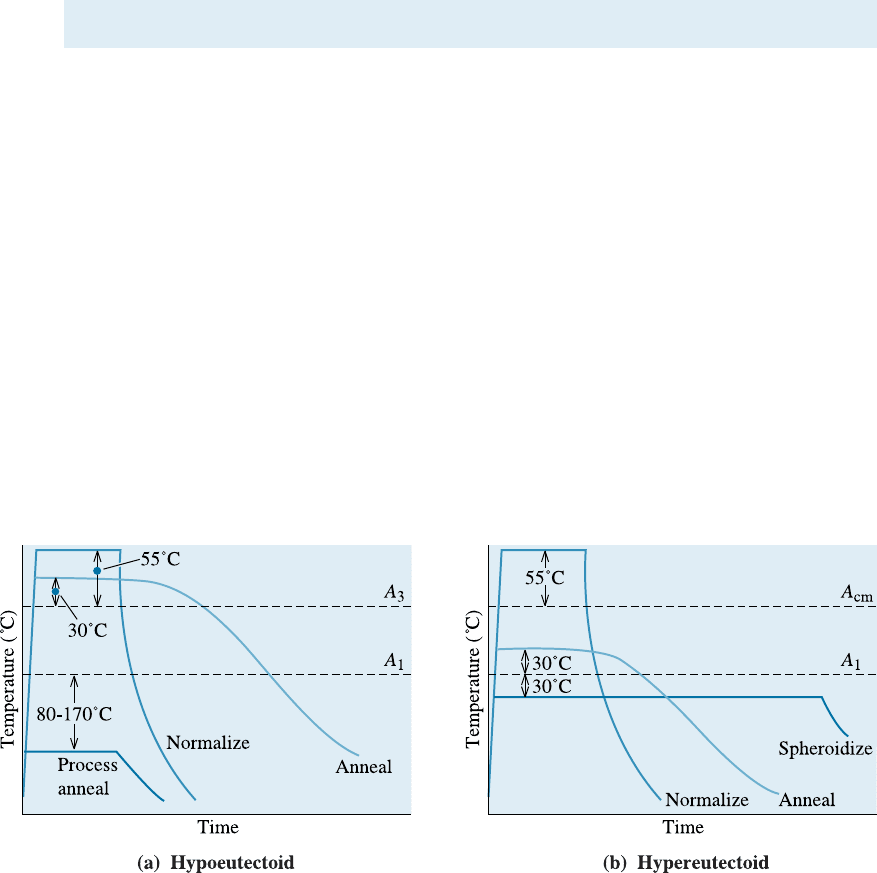
toxin, was replaced with tin (Sn) and/or antimony (Sb). Steels can also be classified
based on their processing. For example, the term ‘‘concast steels’’ refers to continuously
cast steels. Galvanized steels have a zinc coating for corrosion resistance. Similarly, tin-
plated steel is used to make cor rosion-resistant tin cans and other products. Tin is de-
posited using electroplating—a process known as ‘‘continuous web electrodeposition.’’
‘‘E-steels’’ are steels that are melted using an electric furnace, while ‘‘B-steels’’ contain
a small (0.0005 to 0.003%), yet significant, concentration of boron. Recently, a ‘‘germ-
resistant’’ coated stainless steel has been developed. Some biomedical products, such as
cardiovascular stents, also make use of stainless steel coated with heprin, a chemical
that makes the stents more biocompatible.
13-2 Simple Heat Treatments
Four simple heat treatments—process annealing, annealing, normalizing, and
spheroidizing—are commonly used for steels (Figure 13-3). These heat treatments are
used to accomplish one of three purposes: (1) eliminating the e¤ects of cold work,
(2) controlling dispersion strengthening, or (3) improving machinability.
Process Annealing—Eliminating Cold Work The recrystallization heat treatment used
to eliminate the e¤ect of cold working in steels with less than about 0.25% C is called a
process anneal. The process anneal is done 80 to 170
C below the A
1
temperature. The
goal of the process anneal treatment for steels is similar to the annealing of inorganic
glasses in that the main idea is to significan tly reduce or eliminate residual stresses.
Annealing and Normalizing—Dispersion Strengthening Steels can be dispersion
strengthened by controlling the fineness of pearlite. The steel is initially heated to
produce homogeneous austenite (FCC g phase), a step called austenitizing. Annealing,
or a full anneal, allows the steel to cool slowly in a furnace, producing coarse
pearlite. In normalizing, the steel is cooled more rapidly in air, producing fine pearlite.
Figure 13-4 shows the typical properties obtained by annealing and normalizing plain-
carbon steels.
Figure 13-3 Schematic summary of the simple heat treatments for (a) hypoeutectoid steels
and (b) hypereutectoid steels.
C HA P T E R 1 3 Heat Treatment of Steels and Cast Irons396
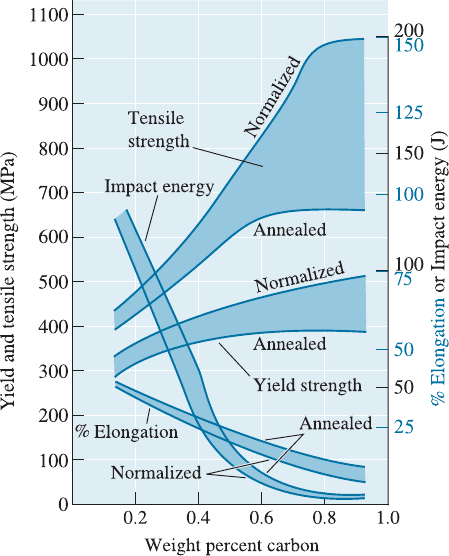
For annealing, austenitizing of hypoeutectoid steels is conducted about 30
C above
the A
3
, producing 100% g. However, austenitizing of a hypereutectoid steel is done at
about 30
C above the A
1
, producing austenite and Fe
3
C. This process prevents the
formation of a brittle, continuous film of Fe
3
C at the grain boundaries that occurs on
slow cooling from the 100% g region. In both cases, the slow furnace cool and coarse
pearlite provide relatively low strength and good ductility.
For normalizing, austenitizing is done at about 55
C above the A
3
or A
cm
; the steel
is then removed from the furnace and cooled in air. The faster cooling gives fine pearlite
and provides higher strength.
Spheroidizing—Improving Machinability Steels, which contain a large concentration
of Fe
3
C, have poor machining characteristics. It is possible to transform the morphol-
ogy of Fe
3
C using spheroidizing. During the spheroidizing treatment, which requires
several hours at about 30
C below the A
1
, the Fe
3
C phase morphology changes into
large, spherical particles in order to reduce boundary area. The microstructure, known
as spheroidite, has a continuous matrix of soft, machinable ferrite (Figure 13-5). After
machining, the steel is given a more sophisticated heat treatment to produce the re-
quired properties. A similar microstructure occurs when martensite is tempered just
below the A
1
for long periods of time. The di¤erence between tempered martensite and
spheroidite is that in formation of spheroidite, martensite is never formed. As noted
before, alloying elements such as Pb and S are also added to improve machinability of
steels and, more recently, lead-free ‘‘green steels’’ that have very good machinability
have been developed.
The following example shows how di¤erent heat treatment conditions can be de-
veloped for a given composition of steel.
Figure 13-4
The effect of carbon and heat
treatment on the properties of
plain-carbon steels.
13-2 Simple Heat Treatments 397
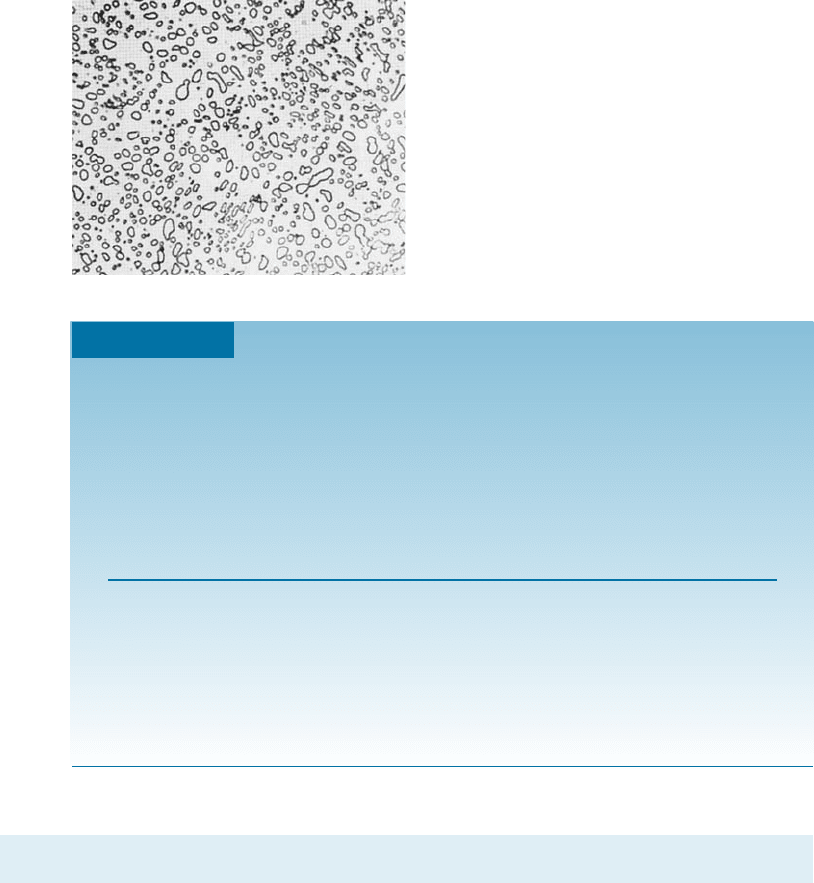
Figure 13-5
The microstructure of spheroidite, with Fe
3
C
particles dispersed in a ferrite matrix (850).
(From ASM Handbook, Vol. 7, (1972), ASM
International, Materials Park, OH 44073.)
EXAMPLE 13-2
Determination of Heat Treating Temperatures
Recommend temperatures for the process annealing, annealing, normalizing,
and spheroidizing of 1020, 1077, and 10120 steels.
SOLUTION
From Figure 13-1, we find the critical A
1
, A
3
,orA
cm
temperatures for each
steel. We can then specify the heat treatment based on these temperatures.
Steel Type 1020 1077 10120
Critical temperatures A
1
¼ 727
C A
1
¼ 727
C A
1
¼ 727
C
A
3
¼ 830
C A
cm
¼ 895
C
Process annealing 727 (80 to 170)
¼ 557
C to 647
C
Not done Not done
Annealing 830 þ 30 ¼ 860
C 727 þ 30 ¼ 757
C 727 þ 30 ¼ 757
C
Normalizing 830 þ 55 ¼ 885
C 727 þ 55 ¼ 782
C 895 þ 55 ¼ 950
C
Spheroidizing Not done 727 30 ¼ 697
C 727 30 ¼ 697
C
13-3 Isothermal Heat Treatments
The e¤ect of transformation temperature on the properties of a 1080 (eutectoid) steel
was discussed in Chapter 12. As the isothermal transformation temperature decreases,
pearlite becomes progressively finer before bainite begins to form. At very low temper-
atures, martensite is obtained.
Austempering and Isothermal Annealing The isothermal transformation heat treat-
ment used to produce bainite, called austempering, simply involves austenitizing the
steel, quenching to some temperature below the nose of the TTT curve, and holding at
that temperature until all of the austenite transforms to bainite (Figure 13-6).
Annealing and normalizing are usually used to control the fineness of pearlite.
However, pearlite forme d by an isothermal anneal (Figure 13-6) may give more uniform
properties, since the cooling rates and microstructure obtained during annealing and
normalizing vary across the cross section of the steel. Note t hat the TTT diagrams only
C HA P T E R 1 3 Heat Treatment of Steels and Cast Irons398
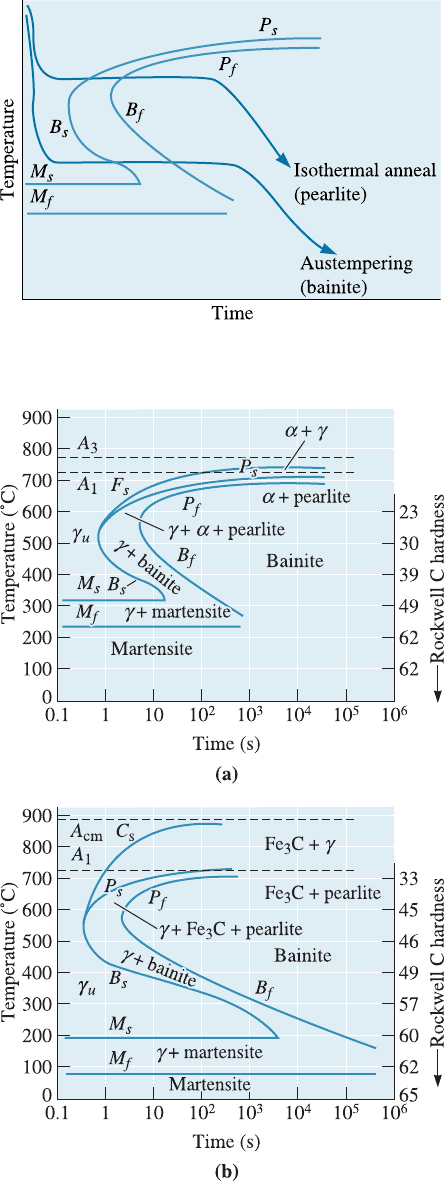
P ¼ Pearlite
B ¼ Bainite
M ¼ Martensite
s ¼ Start
f ¼ Finish
Figure 13-6 The austempering and isothermal anneal heat treatments in a 1080 steel.
P ¼ Pearlite
B ¼ Bainite
M ¼ Martensite
s ¼ Start
f ¼ Finish
g
u
¼ Unstable gamma phase
Figure 13-7 The TTT diagrams for (a) a 1050 and (b) a 10110 steel.
13-3 Is othermal Heat Treatments 399
